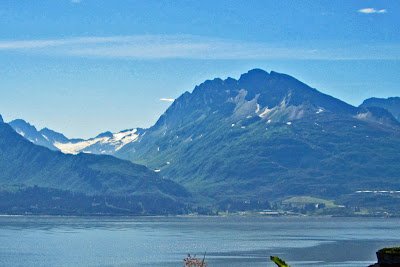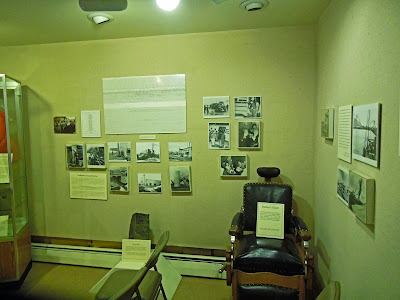 | |
| At present: a much retreated Valdez Glacier |
New Valdez now.
Location of the Old town at foot of the hills.
In the 1970's, completed 1977, along came the Trans-Alaskan Pipe Line and that made a difference in this town--as well as a lot of the state. The terminus of the 800 mile pipeline is here, where the oil is loaded onto ships.
Pipeline terminus as seen from town
One of the ships loaded here in 1989 was the now infamous Exxon Valdez which unfortunately unloaded a good part of their cargo before they got to their destination. The oil spill happened at Bligh Reef. Happily for the town, none of the spilled oil reached town, but Valdez was the center of operations for the clean-up and the press. We saw lot's of information in town on this.
This is a long zoom shot of the marker where the Exxon Valdez hit the reef--taken from a long way out--30 miles from the marker. We were aboard a Prince William Sound wildlife cruise. As you probably remember, the wreck resulted in a terrible loss of wildlife and damage to the Sound--from which it is still recovering. More Information:
http://en.wikipedia.org/wiki/Exxon_Valdez_oil_spill
In case you think Valdez' marine location prevents a lot of snow; wrong. Valdez' average snowfall is 25 FEET from October to May! How would you have liked to be here in January 1990 when it snowed 47 1/2 inches in ONE day? We had the pleasure of speaking with the local meteorologist.
Tired of the history? Me too. Lets go to a museum. (No history there, right?)
Here, outside the Valdez Museum and Historical Archives, My Dear Bride provides scale for the Pipeline pipe. Inside the pipe is a machine that goes from one end of the pipe to the other. This scrubber cleans off the wax buildup from wax added to the oil to make it flow better.
And there is wildlife in Valdez.
This was the only rabbit we saw in Alaska. Think she's lonely?
Here is a beautifully restored 1898 Hand-pump Fire truck
This is a restored 1907 Steam-Powered Fire truck.
Two large model planes of two companies that became pretty big here in Alaska, Reese Airways and Meals Eagle Rock Lines.
A beautiful Painting by a well known Alaskan artist (Can't find her name. Sorry)
 | |
| This features Alaskan Cotton in a dried arrangement |
This was (& still is) a hat with flowers
A very nice quilt, featuring marine life.
We have seen quite a few of these pieces of Diamond Willow. This piece was rare due to it's large size. Very pretty. We see a lot of smaller ones being sold as hiking sticks or canes.
old time barbershop display
 |
| Washing & sewing machines |
more antique machines
Styles of the 60's are antiques too?!!
These are some of the display's in the museum. Kind of self explanatory, except for this one of My Dear Bride smelling a magazine.
Another Fire Truck 1921 Chemical Fire Truck
A 1942 Ford Champion Fire Truck
There was a video & exhibits on the Oil Spill
And the pipeline, including the first barrel of oil that came thru the line.
My Dear Bride can be seen looking thru the old lighthouse lens
from Cape Hachinbrook Lighthouse This is very similar to some Fresnel lenses we've seen in Oregon.
I also found a gun big enough to go bear hunting.
But they wouldn't let me take it home. Darn!
As I am sure you realize (and are very happy about it), we didn't take picture of everything but you get the idea. Lot's to see. Even outside
Large containers of lovely combinations of flowers outside the museum. My Bride wants to take just one to the Honda, pot that is, not the flowers. (Chuck never gave me that choice . . . too late now.)
After the museum we headed for a place where we were we would almost be certain to see bears: the Fish hatchery at Salmon Gulch Salmon Creek.
We saw several sights on the way including Valdez Harbor
A barge with the oil leakage protection around it.
A pretty little waterfalls spilling into a lagoon beside the road. Oft times bears are seen here.
This is a weir blocking the salmon from entering Salmon Creek. There is now a power plnnt using the creek and if the salmon get into the creek it would really foul up the machinery. They do have a hatchery here that takes most of the fish so they can do their thing. If you look close you can see a of of fish and the run is just starting.
Still a lot of salmon are trying to get in.
This is above where the salmon are blocked, To the right is the Hatchery.
This is where they want to go, up Salmon Creek falls.
The hatchery was closed all the times we were there so we did not to see their operation.
But no luck seeing the bears. We went to the Elks Club and had a nice dinner and back to the RV to get ready for the cruise to the Columbia Glacier tomorrow. Hope to see you there.


































No comments:
Post a Comment